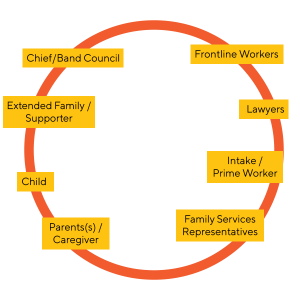The Circle Process
Talking Together is a circular process. ‘A Circle’ is a basic Aboriginal symbol. It is also a symbol of Indian Justice. In a Circle, there is no right or left, nor is there a beginning or an end. Every point (person) seated in a circle looks to the same center as the focus. The Circle is the symbol of justice because it is perfect, unbroken, and a simile of unity and oneness. It conveys the image of people gathering together for discussion.
The drawing together of people who know the family, and care about the family, can be a very powerful process. If one considers the solutions that a child welfare organization has available for the family e.g. alcohol treatment, parenting courses, and counselling as a bundle of solutions – in the circle, the bundle has the potential of being much bigger and can be tailor-made to fit the needs of this particular family.
Key to the Talking Together Circle is the importance of confidentiality, the sacredness of the Circle, and the feeling of safety and being heard.
- A referral is received. The referral is assessed, and the referent is notified of the outcome of the referral. If approved, the referral is forwarded to the appropriate Talking Together Facilitator (TTF).
- Within 5 days from the referral being approved, the TTF contacts all participants to schedule a Talking Together Circle.
- Prior to the Circle starting, participants are informed of the confidentiality and sacredness of the Circle. Participants are also required to sign an “Oath of Confidentiality”.
- After the Circle takes place, and within 5 working days, the TTF provides a copy of the Circle Report/Agreement to the client(s), the child welfare agency and any other significant participant.
- Further follow-up Circles are scheduled and action items are discussed as necessary.
The Facilitator is responsible for maintaining contact, to ensure that the circle agreement is being followed. - If after 30 days of no contact between the client and TTF or the TTF is unable to locate client, the file is closed.
The Circle Participants

- Parent(s), guardians and foster parent(s)
- The child or the children
- Key persons involved in helping the family, e.g. family members, elders, social workers, and counsellors.
Goal of Talking Together
The Talking Together Program is a process based on traditional circles. Circles were used since time immemorial to restore harmony between family members.
The goal of Talking Together is to bring participants together to discuss family problems in a non-judgmental way. The Circle is composed of family members, front-line workers, agency representatives, community elders and Band Council representatives.
In the Circle, participants look at who has been affected and how they have been affected by the problems that the family is experiencing. Secondly, in the Circle, participants are asked: What can be done? If and when an agreement is reached, it is used as the basis for the Plan of Care.
The ultimate goal of Talking Together is to keep families together as a healthy and strong unit.